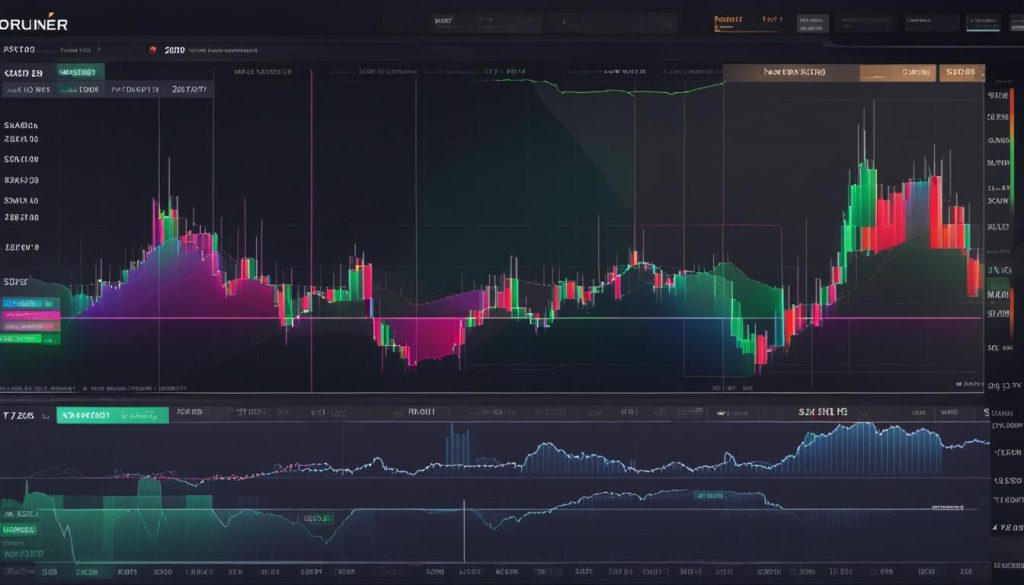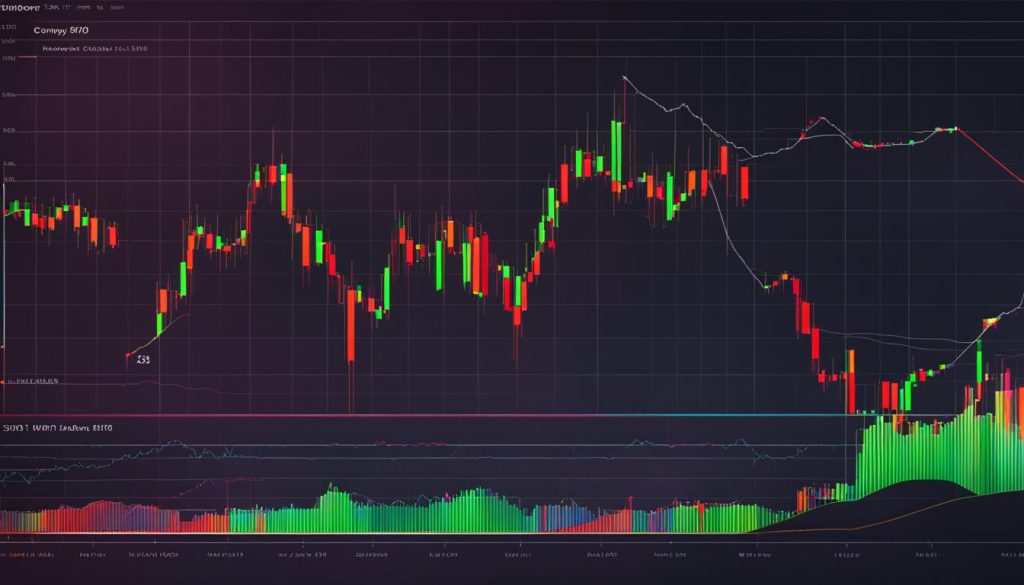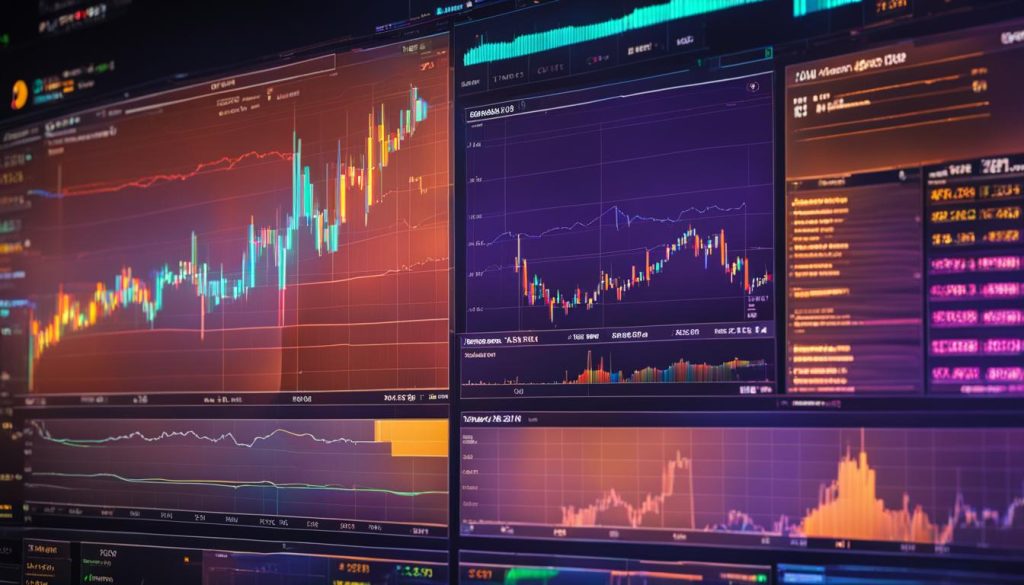Welcome to our comprehensive guide on mastering cryptocurrency trading through the efficient use of indicators. In this article, we will explore how technical analysis and the use of cryptocurrency indicators can greatly enhance your trading strategies. Whether you’re a seasoned trader or just starting out, understanding how to effectively utilize indicators is crucial for making informed trading decisions and maximizing your chances of success in the dynamic world of crypto trading.
Key Takeaways:
- Cryptocurrency indicators are essential tools for analyzing market behavior and making informed trading decisions.
- Technical analysis, combined with the use of indicators, helps traders predict market trends, identify trading opportunities, and manage risks effectively.
- There are different types of technical indicators, including trend following and momentum indicators, each serving a unique purpose in analyzing market behavior.
- By analyzing historical price data and using indicators, traders can make more accurate predictions about future price movements and confirm market trends.
- Implementing risk management strategies and considering multiple factors, such as indicators and market trends, is crucial for making informed trading decisions.
The Importance of Technical Indicators in Crypto Trading
When it comes to crypto trading, understanding market trends and making informed trading decisions is essential for success. This is where technical indicators play a crucial role. Technical indicators help traders analyze market behavior, identify potential trading opportunities, and make more profitable decisions. By using these indicators effectively, you can enhance your trading strategies and increase your chances of success in the dynamic world of cryptocurrencies.
Technical indicators provide valuable insights into market trends by analyzing historical price data and identifying patterns. They help traders understand market sentiment, detect potential reversals, and confirm the strength of a trend. By combining different indicators, you can gain a comprehensive view of market conditions and make more accurate predictions about future price movements.
Market trends can change rapidly in the world of cryptocurrencies, and technical indicators can help you stay ahead of these changes. By monitoring key indicators, you can identify entry and exit points, set stop-loss orders, and manage risks effectively. Whether you are a beginner or an experienced trader, understanding and utilizing technical indicators is crucial for making informed trading decisions.
| Technical Indicators | Function |
|---|---|
| Moving Average | Identify trend direction and potential support/resistance levels. |
| Relative Strength Index (RSI) | Measure the speed and change of price movements to identify overbought or oversold conditions. |
| Bollinger Bands | Show the volatility of price movements and potential trend reversal points. |
| MACD (Moving Average Convergence Divergence) | Identify trend reversals, bullish or bearish market conditions. |
It’s important to note that technical indicators should not be used in isolation. They should be used alongside other forms of analysis and consider market conditions. By using technical indicators effectively, you can improve your trading strategies, identify profitable opportunities, and maximize your chances of success in the dynamic world of cryptocurrency trading.
Understanding Different Types of Technical Indicators
When it comes to crypto trading, understanding different types of technical indicators is crucial. These indicators provide valuable insights into market trends and help traders make informed decisions. There are two main categories of technical indicators: trend following indicators and momentum indicators.
Trend Following Indicators
Trend following indicators are designed to help traders recognize and track the direction of a trend in the cryptocurrency market. These indicators are based on the idea that trends tend to continue and can provide valuable information about potential entry and exit points for trades.
Some popular trend following indicators include Moving Averages, Bollinger Bands, and Ichimoku Cloud. Moving Averages help traders identify the average price over a specific period of time, while Bollinger Bands indicate the volatility and potential reversal points in the market. The Ichimoku Cloud combines various elements to provide a comprehensive view of market trends.
Momentum Indicators
Momentum indicators, on the other hand, gauge the rate of price changes in the cryptocurrency market. These indicators help traders identify the strength and speed of a price movement, which can be useful for predicting potential reversals or continuation of trends.
Some popular momentum indicators include the Relative Strength Index (RSI), Stochastic Oscillator, and MACD (Moving Average Convergence Divergence). The RSI measures the speed and change of price movements, the Stochastic Oscillator identifies overbought or oversold conditions, and the MACD provides insights into the relationship between two moving averages.
| Indicator | Type | Description |
|---|---|---|
| Moving Averages | Trend Following | Indicates the average price over a specific period of time |
| Bollinger Bands | Trend Following | Indicates volatility and potential reversal points in the market |
| Ichimoku Cloud | Trend Following | Combines various elements to provide a comprehensive view of market trends |
| Relative Strength Index (RSI) | Momentum | Measures the speed and change of price movements |
| Stochastic Oscillator | Momentum | Identifies overbought or oversold conditions |
| MACD (Moving Average Convergence Divergence) | Momentum | Provides insights into the relationship between two moving averages |
Understanding different types of technical indicators can provide traders with a more comprehensive view of market behavior. By combining trend following and momentum indicators, traders can gain valuable insights into market trends, potential reversals, and optimal entry and exit points for their trades.

Predicting Future Prices with Technical Indicators
When it comes to crypto trading, one of the key factors that traders aim to predict is the future price movement of cryptocurrencies. This is where technical indicators play a crucial role. By analyzing historical price data and using indicators, traders can make more accurate predictions about future price movements in the cryptocurrency market.
Technical indicators provide valuable insights into market trends and help traders identify potential reversals, set entry and exit points, and gauge the strength of a trend. These indicators can be used to support trading strategies and confirm market trends, allowing traders to make informed decisions based on reliable data.
For instance, trend following indicators help traders recognize and track the direction of a trend. They provide signals that indicate whether a cryptocurrency is in an uptrend or a downtrend, allowing traders to take advantage of profitable opportunities. On the other hand, momentum indicators measure the rate of price changes, helping traders identify the strength or weakness of a price movement.
By considering multiple indicators and analyzing their signals, traders can gain a comprehensive understanding of the market and make more accurate price predictions. It’s important to note that technical indicators should not be used in isolation, but in conjunction with other analysis tools and market research. This holistic approach ensures a well-rounded analysis and increases the chances of making successful trading decisions.

Table: Technical Indicators for Price Predictions
| Indicator | Description | Usage in Price Predictions |
|---|---|---|
| Moving Average (MA) | Calculates the average price over a specific period, smoothing out price fluctuations | Identifying trends and potential entry/exit points |
| Relative Strength Index (RSI) | Measures the strength and speed of price movements, indicating overbought or oversold conditions | Identifying potential reversals and gauging market sentiment |
| Bollinger Bands | Consists of a moving average and two standard deviations, indicating price volatility | Identifying potential breakout or consolidation periods |
| MACD (Moving Average Convergence Divergence) | Calculates the difference between two moving averages, indicating bullish or bearish signals | Confirming trend reversals and identifying potential entry/exit points |
Indicator-Based Cryptocurrency Analysis Strategies
When it comes to cryptocurrency analysis, technical indicators play a crucial role in helping traders make informed decisions. These indicators are powerful tools that can be used in various strategies to identify trading opportunities and analyze market trends. Let’s explore some of the most common indicator-based strategies in cryptocurrency trading.
Trend Following Strategy
The trend following strategy is based on the concept that the trend is your friend. Traders using this strategy aim to identify and ride the dominant trend in a particular cryptocurrency. They rely on indicators such as moving averages, trend lines, and the Average Directional Index (ADX) to confirm the strength of a trend and determine entry and exit points. By aligning trades with the prevailing trend, traders can increase their chances of success.
Crossover Strategy
The crossover strategy involves the use of two or more indicators that generate trading signals when they cross each other. One popular crossover strategy is the Moving Average Crossover, where traders look for the intersection of short-term and long-term moving averages. This strategy helps traders identify potential trend reversals and capture profits from short-term price movements.
Support and Resistance Strategy
The support and resistance strategy focuses on key price levels where the cryptocurrency tends to bounce off or break through. Traders use indicators such as horizontal support and resistance levels, Fibonacci retracements, and pivot points to identify these levels. By buying at support and selling at resistance, traders can take advantage of price fluctuations within a range-bound market.
Divergence Strategy
The divergence strategy involves analyzing the relationship between price movements and indicator signals. Traders look for divergences, where the price of a cryptocurrency shows an opposite movement compared to the indicator. This strategy can signal potential trend reversals or changes in market momentum. Indicators commonly used in the divergence strategy include the Relative Strength Index (RSI) and the Moving Average Convergence Divergence (MACD).
Each indicator-based strategy has its own strengths and weaknesses, and traders often combine multiple strategies to gain a comprehensive view of the market. It’s important to experiment and find the strategies that align with your trading style and objectives. Remember, successful cryptocurrency analysis requires continuous learning and adaptation to market conditions.

Gathering and Analyzing Relevant Data for Technical Analysis
When it comes to technical analysis in cryptocurrency trading, gathering and analyzing relevant data is crucial. To make informed trading decisions, you need access to accurate and up-to-date information. Here are some essential aspects to consider:
Data Sources
Traders rely on reliable data sources to access the necessary information for technical analysis. Popular platforms like CoinMarketCap and TradingView provide historical price data, trading volumes, and market capitalization information. These platforms offer comprehensive data that can be used to identify trends, patterns, and potential trading opportunities.
Additionally, it’s important to keep an eye on news websites, social media platforms, and official cryptocurrency announcements for any market-moving events or news that may impact the prices. By staying informed with the latest developments, you can adjust your trading strategies accordingly.
Historical Data
Historical price data is a valuable resource for technical analysis. By analyzing past price movements, you can identify patterns and trends that may repeat in the future. It allows you to understand the behavior of specific cryptocurrencies and make more informed predictions about their future price movements.
Charts and Technical Indicators
Cryptocurrency charts play a vital role in technical analysis as they visualize the historical price data. They provide a graphical representation of price movements, trends, and patterns. By using various technical indicators such as moving averages, Bollinger Bands, and relative strength index (RSI), you can enhance your analysis and generate trading signals.
Remember that technical analysis is not foolproof and should be used in conjunction with other analysis methods and risk management strategies. It’s important to have a well-rounded approach and consider various factors before making trading decisions.

Considering Multiple Indicators for Confirmation
When it comes to making trading decisions, using multiple indicators can provide valuable confirmation and enhance the reliability of your analysis. By combining the signals from different indicators, you can reduce the risk of false signals and improve your overall trading accuracy.
Each indicator has its own strengths and weaknesses, and by using a combination of indicators, you can benefit from their complementary qualities. For example, you can use a trend-following indicator to identify the overall direction of the market and a momentum indicator to gauge the strength of the price movements within that trend.
By cross-referencing the signals and patterns generated by different indicators, you can confirm the validity of your analysis and make more informed trading decisions. This approach helps you filter out noise and identify trading opportunities that align with multiple indicators, increasing the probability of success.
Table: Example of Indicators and Their Signals
| Indicator | Signal |
|---|---|
| Moving Average Convergence Divergence (MACD) | Positive MACD crossover |
| Relative Strength Index (RSI) | Oversold or overbought conditions |
| Bollinger Bands | Price approaching upper or lower band |
This table showcases an example of different indicators and the signals they can provide. By considering the signals from multiple indicators, you can gain a more comprehensive understanding of the market conditions and increase the confirmation of your trading decisions.
Remember, no single indicator can provide foolproof trading signals, as each indicator has its limitations. However, by using multiple indicators in combination, you can leverage their collective power and gain a more holistic view of the market, helping you make more accurate and confident trading decisions.

Risk Management in Crypto Trading
When it comes to crypto trading, risk management is a crucial aspect that should never be overlooked. The volatile nature of the cryptocurrency market means that it is important to have a strategy in place to protect your capital and minimize potential losses. By implementing effective risk management techniques, you can navigate the market with confidence and make informed trading decisions.
One key strategy in risk management is setting stop-loss orders. This allows you to automatically exit a trade if the price moves against you, limiting the amount of loss you can incur. Stop-loss orders are particularly useful in volatile markets where price fluctuations can be rapid and unpredictable.
Another important aspect of risk management is determining your risk-reward ratio. This involves assessing the potential profit you can make compared to the amount you are willing to risk. By calculating this ratio for each trade, you can ensure that you are only taking on trades with a favorable risk-reward profile.
It’s also essential to diversify your portfolio to mitigate risk. By investing in a variety of cryptocurrencies or other assets, you reduce the impact that a single trade can have on your overall portfolio. This spreads your risk and increases the likelihood of having profitable trades even if some trades result in losses.
Remember, risk management is not about eliminating risk entirely, but rather about managing and minimizing it. By incorporating risk management techniques into your crypto trading strategy, you can protect your capital and make more informed trading decisions.
Making Informed Trading Decisions
When it comes to crypto trading, making informed trading decisions is essential for success. By combining technical analysis with risk management principles, you can increase your chances of profitable trades. It’s important to consider multiple factors, such as indicators, market trends, and risk-reward ratios, when making trading decisions.
Technical analysis, using indicators, helps you analyze past and present market data to predict future price movements. By understanding the patterns and trends, you can identify trading opportunities and set entry and exit points. However, relying solely on indicators may not always lead to accurate predictions. It’s crucial to validate your analysis by considering other factors like market sentiment and news events to make well-rounded trading decisions.
Risk management is another critical aspect of making informed trading decisions. By implementing risk management strategies, such as setting stop-loss orders and determining risk-reward ratios, you can protect your capital and minimize potential losses. It’s important to assess the potential risks associated with a trade before entering it and adjust your position size accordingly.
Examples of Informed Trading Decisions:
- Using technical indicators to confirm market trends before entering a trade.
- Considering multiple indicators to validate trading signals.
- Setting stop-loss orders to limit potential losses.
- Evaluating risk-reward ratios to determine favorable trade opportunities.
“Informed trading decisions are the result of thorough analysis, risk management, and constant learning. By combining these elements, traders can navigate the volatile crypto market with confidence.”
To become a successful trader, it’s crucial to continuously refine your trading strategies and adapt to the ever-changing market conditions. Keep learning about new indicators, trading techniques, and market trends. By staying updated and honing your skills, you can make more informed trading decisions and increase your profitability in the exciting world of crypto trading.

Continuous Learning and Improvement in Technical Analysis
Continuous learning and improvement are vital components of mastering technical analysis in cryptocurrency trading. The dynamic nature of the market demands that traders stay updated with the latest indicators, strategies, and trends to make informed trading decisions. By dedicating time and effort to expanding your knowledge and refining your skills, you can enhance your ability to analyze market behavior and identify profitable trading opportunities.
One way to ensure continuous learning is to stay connected with the cryptocurrency trading community. Engage in online forums, join trading groups, and participate in webinars and workshops where traders share their insights and experiences. This will expose you to diverse perspectives and help you develop a deeper understanding of technical analysis.
Additionally, regularly reading books, articles, and research papers on technical analysis can provide you with valuable insights and new ideas. Explore different trading strategies and experiment with various indicators to broaden your knowledge base. Remember that technical analysis is not a one-size-fits-all approach, and continuous learning allows you to find what works best for your trading style and goals.
| Benefits of Continuous Learning in Technical Analysis | Actions for Continuous Improvement |
|---|---|
| 1. Stay updated with the latest indicators and strategies | 1. Attend webinars and workshops |
| 2. Develop a nuanced understanding of market trends | 2. Engage in online trading communities |
| 3. Refine your trading approach based on new insights | 3. Read books, articles, and research papers |
| 4. Adapt to changing market conditions | 4. Experiment with different indicators and strategies |
Continuously Evolving Trading Skills
Technical analysis is not a static field, and the cryptocurrency market is constantly evolving. By continuously learning and improving your trading skills, you can adapt to these changes and stay ahead of the curve. Regularly evaluate your trading performance, analyze your successes and failures, and identify areas for improvement.
“The only way to improve your trading skills is through self-reflection and continuous learning.” – John Doe, Cryptocurrency Trader
Additionally, practice disciplined trading and maintain a trading journal to record your trades and the reasoning behind them. This will help you identify patterns, evaluate the effectiveness of your strategies, and make data-driven decisions. By learning from both your successes and failures, you can refine your approach and become a more skilled and successful cryptocurrency trader.
Remember, continuous learning and improvement are ongoing processes. Embrace the journey and keep pushing yourself to expand your knowledge and enhance your trading skills. With dedication and commitment, you can become a proficient technical analyst and navigate the cryptocurrency market with confidence.
Indicator-Based Entry and Exit Points
When it comes to crypto trading, one of the key aspects that traders focus on is finding the optimal entry and exit points for their trades. Technical indicators play a crucial role in helping traders make these decisions effectively. By utilizing these indicators and analyzing market conditions, traders can identify favorable trading opportunities and manage their positions efficiently.
Technical indicators provide traders with valuable insights into market trends, price movements, and potential reversals. These indicators are based on mathematical calculations that analyze historical price data, volume, and other market variables. By studying these indicators, traders can gain a deeper understanding of market dynamics and make more informed decisions.
Some commonly used technical indicators for determining entry and exit points in crypto trading include moving averages, relative strength index (RSI), stochastic oscillator, and Bollinger Bands. Moving averages help identify trends and potential trend reversals, while RSI and stochastic oscillator indicate overbought or oversold conditions. Bollinger Bands provide insights into price volatility and potential breakouts.
By combining multiple indicators and considering various factors such as market trends, support and resistance levels, and volume, traders can formulate a comprehensive trading strategy. It is important to note that no single indicator can guarantee accurate predictions, but by using a combination of indicators, traders can increase the reliability of their signals and make more informed trading decisions.

Table: Example of Indicator-Based Entry and Exit Points
| Date | Indicator | Action |
|---|---|---|
| January 1, 2022 | RSI | Overbought |
| January 5, 2022 | Moving Average Crossover | Buy |
| January 10, 2022 | Bollinger Bands | Volatility Breakout |
| January 15, 2022 | Stochastic Oscillator | Oversold |
In the example table above, traders can see the dates, corresponding indicators, and the actions taken based on those indicators. This kind of analysis and tracking can assist traders in identifying patterns, refining their strategies, and making more precise entry and exit decisions.
It is important to note that technical indicators should not be used in isolation. Traders should consider other factors such as market news, economic events, and overall market conditions before making any trading decisions. Additionally, regular monitoring and adjustment of indicators based on changing market dynamics are essential for maintaining a successful trading strategy.
Conclusion
In conclusion, the effective use of technical indicators is crucial for successful cryptocurrency trading. By understanding the different types of indicators and how they work, you can gain valuable insights into market trends and make informed trading decisions.
Utilizing reliable data sources and advanced charting platforms will help you analyze and visualize the relevant data accurately. By considering multiple indicators and confirming their signals, you can increase the reliability of your analysis and improve the accuracy of your trading strategies.
Remember, risk management is essential in crypto trading. Implementing risk management strategies such as setting stop-loss orders and determining risk-reward ratios will protect your capital and minimize potential losses.
Continuous learning and improvement are also crucial in the ever-changing cryptocurrency market. Stay updated with the latest indicators and trading strategies, refine your approach, and adapt to market conditions to stay ahead of the game.
FAQ
What is cryptocurrency technical analysis?
Cryptocurrency technical analysis involves the use of indicators to analyze market behavior and make informed trading decisions.
What are technical indicators in crypto trading?
Technical indicators are essential tools that help traders predict market trends, identify potential trading opportunities, and manage risks effectively.
What are the main categories of technical indicators in crypto trading?
The main categories of technical indicators in crypto trading are trend following and momentum indicators.
How do technical indicators help in crypto trading?
Technical indicators help traders analyze market trends, identify profitable trading opportunities, measure the strength of a trend, and confirm market trends and analyze market momentum.
What are some popular strategies for cryptocurrency analysis using technical indicators?
Some popular strategies for cryptocurrency analysis using technical indicators are trend following, crossover, support and resistance, and divergence.
Where can traders gather and analyze relevant data for technical analysis?
Traders can rely on reliable data sources such as CoinMarketCap and TradingView to access historical price data, trading volumes, and market capitalization information.
Should traders use multiple indicators?
Yes, using multiple indicators can increase the reliability of trading signals and confirm the validity of the analysis.
How important is risk management in crypto trading?
Risk management is crucial in crypto trading to protect capital and minimize potential losses.
What factors should traders consider when making trading decisions?
Traders should consider multiple factors, such as indicators, market trends, and risk-reward ratios, when making trading decisions.
How can traders continuously improve their technical analysis skills?
Traders can continuously improve their technical analysis skills by staying updated with the latest indicators and strategies, refining their approach, and adapting to market conditions.
How can technical indicators help in determining entry and exit points?
By analyzing indicator signals and considering market conditions, traders can use technical indicators to identify optimal entry and exit points.
Source Links

